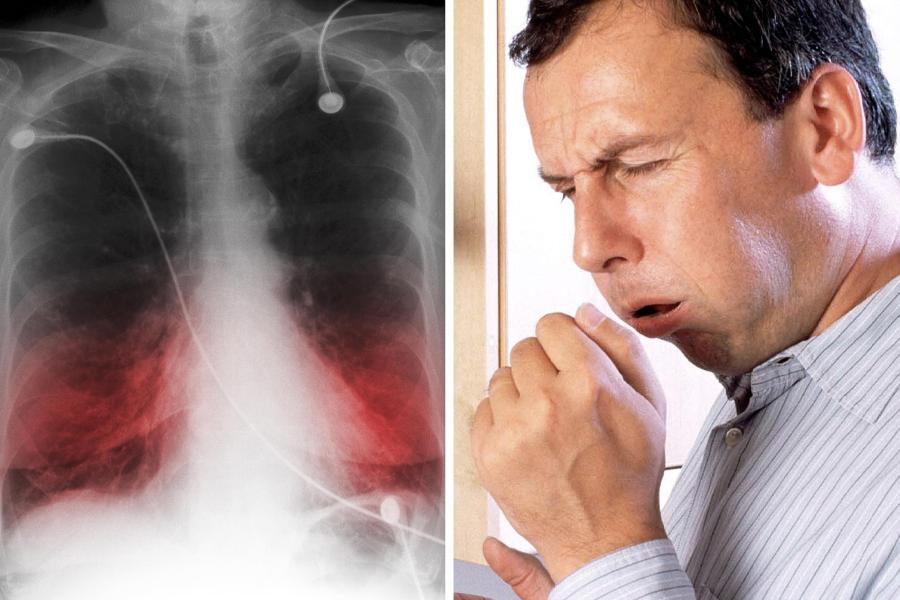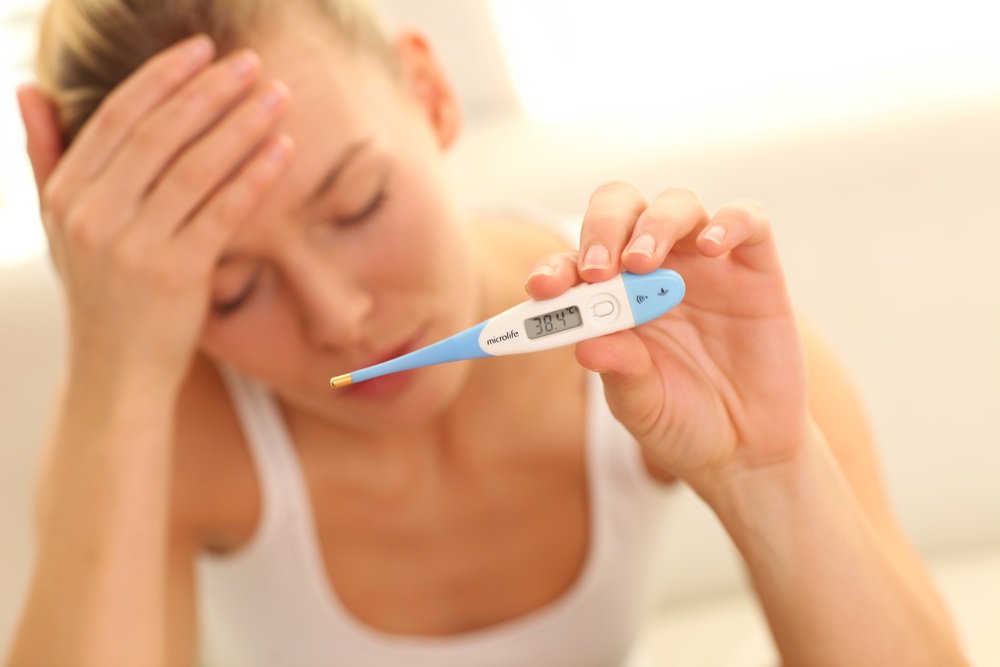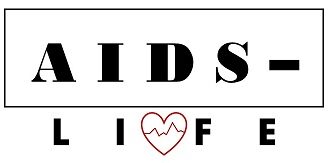Is there a fever when you are infected with HIV?
After the human immunodeficiency virus enters the blood, a number of changes occur that affect vital signs - pulse, temperature, blood pressure. Periodically, their levels decrease and increase, which is associated with the active circulation of pathogenic microflora in the patient’s body. Along with other health criteria, temperature during HIV infection rarely remains within normal limits. Immunodeficiency always causes a violation of thermoregulation. High temperature is defined as hyperthermia, low temperature is hypothermia.
Causes of temperature changes in HIV

In half of the clinical cases, it is possible to determine why the temperature rises with HIV even before visiting the doctor. Some inflammatory processes that occur against the background of immunodeficiency progress on the surface - affecting the skin and mucous membranes. In other cases, it is possible to identify the cause of changes in temperature readings only after undergoing diagnostics - it is prescribed by a specialist.
Hyperthermia occurs due to the inflammatory process. Most often, patients with immunodeficiency experience extensive damage to the lungs, gums, inner surface of the cheeks, and mucous membrane of the palate. Localization of inflammation in the internal organs is the basis for hospitalization of the patient. The main cause of hyperthermia is the spread of the virus and its derivatives through the patient’s blood.
Pneumonia
Inflammation of the lungs develops as a result of toxic damage to this paired organ by substances produced by the human immunodeficiency virus.

The temperature observed in HIV-infected people when pneumonia occurs varies from 38 to 40 °C. The condition is accompanied by multiple symptoms, the main signs:
- increased sweating;
- confusion;
- dyspnea;
- the appearance of a large amount of viscous sputum;
- chills;
- vomit;
- convulsions.
When pneumonia develops against the background of HIV infection in children, they may have a fever for more than 2 weeks, and the origin of the condition cannot be immediately determined.
Stomatitis
Fever in HIV due to stomatitis occurs in 100% of cases. Inflammation of the oral mucosa is accompanied by enlarged lymph nodes, pain during eating, and copious amounts of saliva.

When a high temperature with HIV is caused by stomatitis, it is maintained at 37.5-39.5 °C for 5-6 days. In children suffering from immunodeficiency, hyperthermia persists longer and their condition is more severe.
Vascular complications
As HIV progresses, the patient develops problems with the condition of the blood vessels. Basically, the virus affects the veins and arteries running inside the kidneys. This contributes to the development of glomerulonephritis - inflammation of the glomerular apparatus of the paired organ of the urinary system.
Signs of the condition:
- nausea, weakness;
- discharge of light pink urine;
- dull pain in the lumbar back;
- reduction in the volume of urine excreted;
- increase in body temperature to high numbers;
- decreased appetite;
- dizziness;
- weight loss

Glomerulonephritis is the leading cause of renal failure and the basis for the use of hemodialysis.
Attention! How many days a fever lasts for HIV, among other factors, depends on the age of the patient.
Hyperthermia is preceded by a number of precursor symptoms, including chills, lack of appetite, weakness and dizziness. The listed symptoms appear almost simultaneously. Patients suffering from immunodeficiency are often interested in whether there is a fever with HIV without chills. In this case, experts agree that this does occur.
Neurospeed

Represents damage to the nervous system. It is observed already in the early phase of HIV development. Initially it occurs without hyperthermia, with a minimum number of symptoms. When a fever appears in HIV, the patient experiences a wide range of symptoms, including:
- Headache.
- Confusion.
- Nausea, vomiting.
- Intense production of sweat and saliva.
- Weakness.
- Insomnia.
The listed signs refer to manifestations of meningitis and encephalitis. Both diseases are among the common complications of HIV infection.
Causes of low temperature

Hypothermia in immunodeficiency occurs much less frequently than hyperthermia. Low temperature with HIV accompanies hypotension and anemia. Both conditions often accompany immunodeficiency already at the initial stage of development. A low temperature with HIV is a sign of a lack of microelements and vitamins that are absorbed by the virus of the disease in question. Signs of a condition other than hypothermia:
- dry skin, the appearance of rashes and cracks on it;
- wounds near the mouth;
- nausea;
- hair loss;
- pale skin, dark spots and circles under the eyes;
- brittle nails;
- body exhaustion;
- weakness;
- inability to concentrate;
- insomnia;
- dizziness.
During the consultation, the doctor asks the patient whether his temperature has always decreased with HIV, or whether there have been periods of its increase. Based on the answer, prescriptions are formed and treatment tactics are planned.
To compensate for the amount of nutrients the body lacks, the patient needs to improve the quality of the diet and increase the frequency of meals. Additionally, the doctor prescribes the administration of vitamin complexes.
Body temperature depending on the stage of HIV
The level of temperature in patients suffering from HIV depends, among other things, on the stage of the infectious disease. There are 3 of them in total, the final stage of development of the pathological process is AIDS.

Characteristics of each stage of development of HIV infection:
- Acute phase. It occurs immediately after a person is infected, the average duration of the period is several weeks. At this stage, the patient’s thermoregulation undergoes primary stress, and the body’s protective properties fight them physiologically. Low-grade fever during the acute phase of HIV development is a manifestation of this process. Additional symptoms – chills, general weakness, limitation of physical activity due to a general deterioration in health, lack of appetite;
- Latent (hidden) phase. Attacks of hyperthermia occur occasionally. Apart from the fact that the body temperature periodically rises during latent phase HIV infection, the patient does not experience any other symptoms;
- Active phase. Characterized by frequent occurrence of hyperthermia. The patient quite often falls ill with various viral diseases - from ARVI to herpes. He explains his condition by suffering from hypothermia, a difficult work schedule, and lack of proper rest. A high temperature during HIV infection does not serve as an indicator of what pathology has occurred in the patient. Therefore, it is during the active phase of development of immunodeficiency that a person undergoes diagnostics and learns for the first time that he has an incurable disease.
Upon completion of stage 3 of development, immunodeficiency takes the form of AIDS. The patient’s condition deteriorates significantly due to the direct presence of the virus in the blood and the development of multiple complications. If high fever with HIV in the early stages occurs rarely or is not observed at all, when the infection passes into the AIDS phase, hyperthermia occurs almost after 1 day. Against the background of severe immunodeficiency, the patient develops many diseases - they are not eliminated in the standard way.
Attention! To the question whether HIV can be present without elevated temperature, there is a clear answer - this is excluded: immunodeficiency is always accompanied by hyperthermia.
Only the reason for its development, duration, methods of elimination, tolerability of the condition, and accompanying symptoms differ.
Methods for reducing fever in HIV

Only a doctor can determine how to reduce the temperature of a particular patient with HIV. The specialist takes into account many factors, including the stage of immunodeficiency, the presence of complications, and their severity. Only medicinal treatments are used, therapy is supportive in nature. Despite the incurable nature of the disease, taking medications prescribed by a doctor helps prolong life.
Antibiotics, analgesics, and drugs are used whose action is aimed at easier discharge of viscous sputum.
Since body temperature during HIV infection increases slightly at the initial stage of infection, it is not necessary to reduce it using special methods.
In other cases, the patient is administered antipyretic and antiviral drugs. Additional prescriptions are symptomatic in nature - eliminate pain, stop vomiting, increase or decrease blood pressure. Whether a particular patient has a fever due to HIV depends on several criteria. In general, hyperthermia can be eliminated, but not for a long period of time, since the immunodeficiency virus remains in the blood and continues to progress, causing new complications.

Symptoms of HIV progression also manifest themselves in the form of temperature - often increased, not decreased. Hyperthermia is a reason to visit a doctor and undergo an examination. It is thanks to timely contact with a specialist that it is possible to minimize the severity of immunodeficiency, prevent the development of complications, and increase the survival period.
